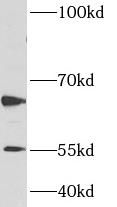Products
CARM1 antibody
Category:
Research Area:
- SPECIFICATIONS
- Product Name
- CARM1 antibody
- Catalogue No.
- FNab01275
- Size
- 100μg
- Form
- liquid
- Purification
- Immunogen affinity purified
- Purity
- ≥95% as determined by SDS-PAGE
- Clonality
- polyclonal
- Isotype
- IgG
- Storage
- PBS with 0.02% sodium azide and 50% glycerol pH 7.3, -20℃ for 12 months(Avoid repeated freeze / thaw cycles.)
Immunogen
- Immunogen
- coactivator-associated arginine methyltransferase 1
- Alternative Names
- CARM1 antibody, PRMT4 antibody
- UniProt ID
- Q86X55
- Observed MW
- 63-66 kDa, 55 kDa
Application
- Tested Applications
- ELISA, IHC, WB, IF
- Recommended dilution
- WB: 1:1000-1:5000; IHC: 1:50-1:500; IF: 1:20-1:200
Validated Images
 NIH/3T cells were subjected to SDS PAGE followed by western blot with FNab01275(CARM1 antibody) at dilution of 1:500
NIH/3T cells were subjected to SDS PAGE followed by western blot with FNab01275(CARM1 antibody) at dilution of 1:500
 Immunohistochemistry of paraffin-embedded human breast cancer using FNab01275(CARM1 antibody) at dilution of 1:50
Immunohistochemistry of paraffin-embedded human breast cancer using FNab01275(CARM1 antibody) at dilution of 1:50
 Immunofluorescent analysis of NIH/3T3 cells using FNab01275 (CARM1 antibody) at dilution of 1:50 and Alexa Fluor 488-conjugated Goat Anti-Rabbit IgG(H+L)
Immunofluorescent analysis of NIH/3T3 cells using FNab01275 (CARM1 antibody) at dilution of 1:50 and Alexa Fluor 488-conjugated Goat Anti-Rabbit IgG(H+L)
- Background
- CARM1, also named as PRMT4, belongs to the protein arginine N-methyltransferase family. It is a dual functional coregulator that facilitates transcription initiation by methylation of Arg17 and Arg26 of histone H3 and also dictates the subsequent coactivator complex disassembly by methylation of the steroid receptor coactivator family coactivators and p300/cAMP-response element-binding protein. CARM1 functions as a coactivator for many nuclear receptors, such as oestrogen receptor, androgen receptor, thyroid receptor and farnesoid X-receptor. It also coactivates other transcription factors such as myocyte enhancer factor 2C (MEF2C), β-catenin, p53, nuclear factor (NF)-kB and the cAMP-responsive element-binding factor. The enzymatic activity and coactivator function of CARM1 has been found to be inactivated through phosphorylation at a conserved serine residue at mitosis stage. This antibody was generated against a synthetic peptide corresponding to a fragment of human CARM1. It is expected to specifically recognize the CRAM1. In certain type of cells, like Hela, double bands can be detected with this antibody. This may due to the additional PTMsites in cells themselves.



